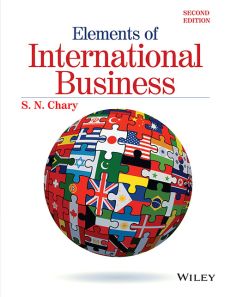Elements of International Business, 2ed
ISBN: 9788126555789
456 pages
Publication Year: 2016
eBook also available for institutional users
For more information write to us at: acadmktg@wiley.com

Description
Business interactions across national boundaries are no longer a matter of choice for organizations. Every nation to a lesser or greater degree is seeing itself as a part of the larger macroeconomic environment. This book is the updated version of the popular original edition. An informative and refreshingly candid volume on the interplay of elements in international business.
Preface
Acknowledgement
Chapter 1 Introduction
1.1 Introduction
1.2 Risks and Opportunities of Going Global
1.3 Activities of International Business
1.4 Historical Aspects of International Business
1.5 The Global Market
1.6 Multinational Corporations
1.7 Developmental Role of the MNCs
1.8 Offshoring of Services and MNCs
1.9 Indian Multinational Corporations
Chapter 2 Intercultural Management
2.1 Introduction
2.2 What is Culture?
2.3 Why is the Study of Culture Important?
2.4 Language of Culture
2.5 Dimensions of Cultural Variability
2.6 Tips While Conducting Business in Different Countries
2.7 Growing International Business and Cultural Changes
Chapter 3 International Trade
3.1 Introduction
3.2 Theories of International Trade
3.3 Strategic Trade Theories
3.4 Government Control of Trade
3.5 Non-Tariff Barriers (NTBs) to International Trade
3.6 India’s Foreign Trade
Chapter 4 International Politics and Economic Integration
4.1 Introduction
4.2 Advantages of Economic Integration
4.3 Types of Economic Integration
4.4 Levels of Integration
4.5 Politics of Economic Integration
4.6 Necessity of Political Initiatives for Economic Integration
4.7 Impediments to Economic Integration
4.8 Developing Countries’ Problems in Economic Integration
4.9 Prognosis for the Developing Nations
4.10 Examples of Integration
4.11 Economic Integration from a Philosophical Angle
Chapter 5 International Organizations
5.1 Introduction
5.2 Bretton Woods Conference
5.3 General Agreement on Tariffs and Trade Instead of the ITO
5.4 GATT ‘Rounds’ of Trade Negotiations
5.5 World Trade Organization
5.6 Fundamental Principles of the WTO Trading System
5.7 Organization of WTO
5.8 General Agreement on Trade in Services
5.9 Trade-Related Aspects of Intellectual Property Rights
5.10 Environmental and Social Issues under WTO
5.11 Are Regional Integration Agreements and WTO Compatible?
5.12 WTO: Its Turbulent Times
5.13 United Nations Conference on Trade and Development
Chapter 6 Foreign Direct Investment – I
6.1 Introduction
6.2 Nations are Selective in Trade
6.3 Defining Foreign Direct Investment
6.4 Why Do Nations Desire FDI?
6.5 Benefits from FDI are Several
6.6 Arguments against FDI
6.7 Theories of FDI
6.8 Classification of FDI
6.9 Strategic Considerations while Investing Abroad
Chapter 7 Foreign Direct Investment – II
7.1 Introduction
7.2 FDI Movements in the World
7.3 FDI Trends for India
7.4 India and China: Comparison of FDI Inflows
7.5 Impact of Government Attitudes and Policies on FDI
7.6 Fine-tuning of Inward FDI: China’s Example
7.7 Apprehensions Regarding FDI
7.8 FDI Incentives
7.9 Outward FDI
7.10 Geopolitics, Foreign Policies and FDI
Chapter 8 Strategies
8.1 Introduction
8.2 What is Strategy?
8.3 International Business as a Strategy
8.4 International Business as a Location Decision
8.5 Production and Operations Strategies
8.6 Strategic Decisions of Technology Transfer
8.7 Research and Development Strategies
8.8 Marketing Strategies
8.9 Human Resource Strategies
Chapter 9 International Business Today and Tomorrow
9.1 Introduction
9.2 International Business and the Role of Technology
9.3 International Manufacturing/Service Operations and Global Supply Chains
9.4 Rapid Strides, but a Long Way to Go
9.5 Outsourcing of Services and the Indian Phenomenon
9.6 Large Indian Companies and their Globalization
9.7 What is in Store for the Future?
9.8 Concern for the Environment
Summary
Questions for Discussion
Suggested Assignments
References
Index

